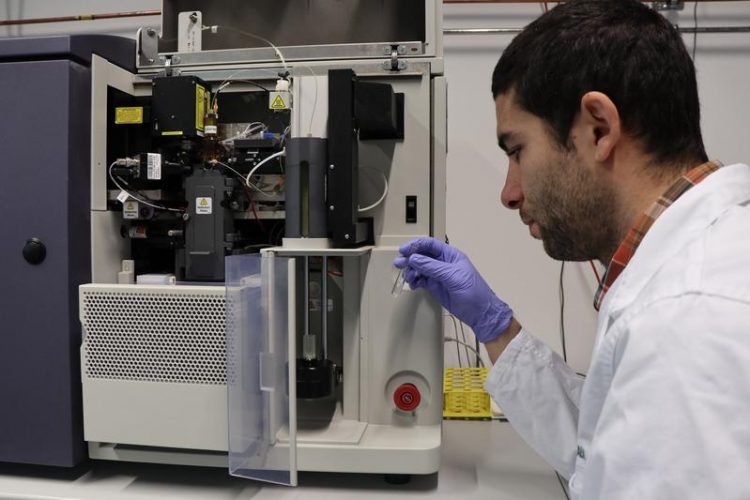More complex biological systems evolve more freely

First author Mato Lagator is analyzing the phenotype of a sample of E. coli mutants. IST Austria
Our genes (aka. the genotype) determine our characteristics (aka. the phenotype). Evolution acts on changes in the phenotype, which occur when mutations change the underlying genotype. But what changes to the phenotype can be produced by mutations is not without bounds – ants cannot suddenly grow a trunk, or become the size of an elephant.
Researchers at the Institute of Science and Technology Austria (IST Austria) found that in a gene regulatory system in the bacterium Escherichia coli, the more components that are mutated, the more freely the system can evolve. This is the result of a study published by a team led by Calin Guet and Jonathan Bollback, with first author postdoc Mato Lagator, in eLife.
Freedom to change
The effects of mutations define how a system can change. But when we take a system composed of several components, such as a system that regulates gene expression, what happens when not only a single component is mutated, but several? Does the system have fewer options for change, or more?
The researchers studied this question in a small gene regulatory system in E. coli that consists of two components: a transcription factor, which is a protein that controls the rate of transcription of genetic information from DNA to RNA; and its binding site on the DNA, where the transcription factor binds to start transcription. In this study, the scientists looked at what happens when they mutate each component on its own, and when they mutate both components at the same time.
Somewhat counterintuitively, they found that the system’s evolution is less limited when more components are mutated. “In stark contrast to what I assumed prior to conducting the experiments, if we mutate several components, the system can evolve more freely. This came as quite a surprise to me!” says first author Mato Lagator. The team then looked at why the system can evolve in more directions, compared to its individual components.
When 1+1 does not equal 2
They found that the system evolves more freely because mutations in the two components interact with each other, a phenomenon they call “intermolecular epistasis”. Mato Lagator explains its significance: “Epistasis means that 1+1 does not equal 2, but 3 or 0. Genetically speaking, one point mutation changes the transcription factor so that the phenotype of our gene regulatory system changes by X, and the other point mutation changes the binding site so that the phenotype changes by Y. Now, when both mutations occur together, the phenotype is not simply X+Y, it is different.” This means that mutations interact, giving the whole system more freedom to change and evolve.
So far, our understanding of epistasis has mostly been descriptive, but how the existing molecular mechanisms define the patterns of epistasis has not been understood. In this study, the researchers give a mechanistic understanding of how the mutations in two different molecules interact, explains Mato Lagator: “Most excitingly, we show that – in this gene regulatory system – most of the epistasis arises from the genetic structure of the system. This structure determines how the mutations interact with each other.”
Additional information
Mato Lagator joined IST Austria in 2013 as an ISTFellow in the groups of Călin Guet and Jonathan Bollback (now at University of Liverpool). The postdoc program ISTFellow has meanwhile evolved into ISTplus, a program focusing on the development of targeted and transferrable skills across all scientific disciplines at IST Austria. The next application deadline is March 15th 2018 (see http://ist.ac.at/research/postdoctoral-research/istplus/).
The research leading to these results has received funding from the People Programme (Marie Curie Actions) of the European Union's Seventh Framework Programme (FP7/2007-2013) under REA grant agreement n°291734.
IST Austria
The Institute of Science and Technology (IST Austria) is a PhD granting research institution located in Klosterneuburg, 18 km from the center of Vienna, Austria. Inaugurated in 2009, the Institute is dedicated to basic research in the natural and mathematical sciences. IST Austria employs professors on a tenure-track system, postdoctoral fellows, and doctoral students. While dedicated to the principle of curiosity-driven research, the Institute owns the rights to all scientific discoveries and is committed to promote their use. The first president of IST Austria is Thomas A. Henzinger, a leading computer scientist and former professor at the University of California in Berkeley, USA, and the EPFL in Lausanne, Switzerland. The graduate school of IST Austria offers fully-funded PhD positions to highly qualified candidates with a bachelor’s or master’s degree in biology, neuroscience, mathematics, computer science, physics, and related areas. See www.ist.ac.at
Source:
Mato Lagator et al: “Regulatory network structure determines patterns of intermolecular epistasis”, elife 2017, DOI: 10.7554/eLife.28921
https://elifesciences.org/articles/28921
https://elifesciences.org/articles/28921 Link to the article in elife
http://ist.ac.at/research/postdoctoral-research/istplus Postdoc program of IST Austria
Media Contact
All latest news from the category: Life Sciences and Chemistry
Articles and reports from the Life Sciences and chemistry area deal with applied and basic research into modern biology, chemistry and human medicine.
Valuable information can be found on a range of life sciences fields including bacteriology, biochemistry, bionics, bioinformatics, biophysics, biotechnology, genetics, geobotany, human biology, marine biology, microbiology, molecular biology, cellular biology, zoology, bioinorganic chemistry, microchemistry and environmental chemistry.
Newest articles

Skyrmions move at record speeds
… a step towards the computing of the future. An international research team led by scientists from the CNRS1 has discovered that the magnetic nanobubbles2 known as skyrmions can be…

A flexible and efficient DC power converter for sustainable-energy microgrids
A new DC-DC power converter is superior to previous designs and paves the way for more efficient, reliable and sustainable energy storage and conversion solutions. The Kobe University development can…

Technical Trials for Easing the (Cosmological) Tension
A new study sorts through models attempting to solve one of the major challenges of contemporary cosmic science, the measurement of its expansion. Thanks to the dizzying growth of cosmic…





















